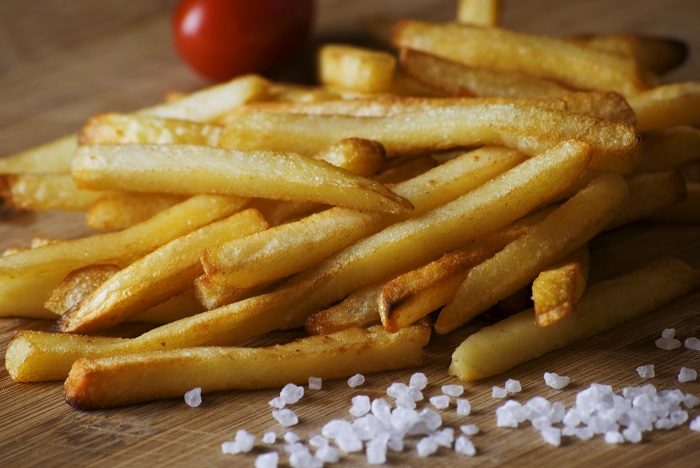
Do you try to be careful about the amount of salt in your diet? Are you pretty sure you’re eating about the right amount of salt (also known as sodium chloride) every day, according to what most experts recommend?
You may be wrong about that.
Even if you throw your salt shaker away, you may still be taking in a lot of sodium — especially if you eat processed or prepared foods. In fact, the majority of sodium in the daily American diet comes from such foods, which are often found on supermarket shelves and in restaurant meals.
 That’s why the U.S. Food and Drug Administration (FDA) is working to gradually reduce the amount of sodium added to foods. The FDA has released a draft guidance for industry that would set voluntary goals for reducing sodium levels in processed and prepared foods. The targets focus on the sodium added to your foods by manufacturers and restaurants before you eat them—not on the salt you add on your own either when cooking or at the table.
That’s why the U.S. Food and Drug Administration (FDA) is working to gradually reduce the amount of sodium added to foods. The FDA has released a draft guidance for industry that would set voluntary goals for reducing sodium levels in processed and prepared foods. The targets focus on the sodium added to your foods by manufacturers and restaurants before you eat them—not on the salt you add on your own either when cooking or at the table.
The goal is to help consumers gradually reduce their daily sodium intake to 2,300 milligrams (mg) per day. That’s about roughly one teaspoon of salt, the daily consumption amount recommended in federal dietary guidelines. Today, Americans consume an average 3,400 mg per day—almost 50 percent more than is generally recommended. That’s putting their health at risk.
“It’s no easy task for consumers to consume the recommended amount of sodium in their diets,” says Susan Mayne, Ph.D., director of FDA’s Center for Food Safety and Applied Nutrition. “We want to help reduce the amount of sodium across the entire food supply by setting reasonable goals.”
“There are few interventions that could potentially have as great an overall benefit to public health,” says Mayne.
Why is Too Much Sodium a Serious Problem?
The words “sodium” and “salt” are often used interchangeably, but there’s a difference. The salt you sprinkle onto your meal or add while cooking is a crystal-like compound (40 percent sodium and 60 percent chloride); sodium, a mineral, is one of the elements found in salt. Salt is how sodium is most often consumed: Between personal use and the salt added to processed and prepared foods, at least 95 percent of the sodium in your diet comes in the form of salt.
Sodium (which the body needs a certain amount of to function properly) occurs naturally in many foods, including celery, beets and milk. And as a food ingredient, sodium — whether from salt or other sodium-containing ingredients — has many uses, such as thickening, enhancing flavor, and preserving foods.
The problem: too much sodium in the diet can lead to high blood pressure, a leading cause of heart disease and stroke. Reducing sodium in foods could prevent hundreds of thousands of premature deaths and illnesses over a decade.
According to the Centers for Disease Control and Prevention, the numbers paint a sobering picture.
90 percent of American adults eat more sodium than is recommended.
Children and adolescents are eating too much sodium too, ranging from 2,900 mg per day for kids 6 to 10 years old, to 3,700 mg for teens age 14 to 18.
The recommended upper limits for sodium consumption for children under 14 are lower than the 2,300 mg limit recommended for older teens and adults. The recommended upper limits for children are 2,200 mg per day for ages 9 to 13; 1,900 mg for ages 4 to 8; and 1,500 mg for ages 1 to 3.
There’s evidence that children who eat higher sodium foods carry that pattern into adulthood.
One in three Americans has high blood pressure, and in African Americans, that number increases to almost half.

What Kinds of Food Can Be High in Sodium?
Processed or prepared foods that are high in sodium include pizza, sandwiches, deli meats, pasta dishes, snacks, salad dressings, soups, and cheese.
But don’t rely on your taste buds, alone. Foods high in sodium don’t always taste salty. While pickles quickly give themselves away, sweet-tasting cereals and pastries also have sodium. In addition, while one serving of a food, like a slice of bread, may not have a lot of sodium, if you eat it several times a day it can add up—and you may be consuming more sodium than you realize.
The Proposed Solution
The FDA is taking an approach to adjusting sodium levels that builds on progress already made by the food industry. The agency has released two- and 10-year draft targets that will establish a system for measuring progress. Many products in the food supply may have already achieved the short-term draft targets; their broader adoption is estimated to reduce sodium intake from 3,400 to 3,000 mg per day.
The long-term draft targets aim to further reduce daily sodium intake to 2,300 mg per day. These targets are more challenging for industry to meet, and may require innovation in the development of new technologies and product formulations.
People generally do not notice small reductions (about 10 to 15 percent) in sodium and, over time, taste buds get used to larger changes, especially if they are made incrementally. So the FDA’s approach allows consumers to gradually become accustomed to the taste of foods that have less sodium.
“This isn’t a ‘one-size-fits-all’ approach. Sodium plays different roles, depending on the food, and each food has a different potential for sodium reduction,” says Kasey Heintz, a biologist in the FDA’s Office of Food Additive Safety.
In salad dressings, for example, the FDA found a variety of sodium content levels among top-selling products and a good deal of potential for reduction. The FDA also sees the potential for significant reductions in many snack foods, given the variation in sodium content in the marketplace.
“That is why the draft guidance document outlines targets for about 150 subcategories of foods within 16 major food categories that contribute to sodium intake,” Heintz says.
The FDA estimates that this strategy could yield annual benefits of $70 billion a year or more in improved health and longevity, as well as in reduced or delayed medical expenses.
The proposed targets also apply to foods prepared in restaurants and other food service establishments. That’s because, according to the U.S. Department of Agriculture’s Economic Research Service, almost half of every food dollar is spent on food consumed outside the home.
What’s Next? A Chance for You to Weigh In
The FDA is seeking public comment before finalizing the targets. Consumers have until August 31, 2016 to comment on issues 1 through 4 listed in section IV of the draft guidance and until October 31, 2016 for comment on issues 5 through 8.
“We know that many companies have already taken steps on their own to reduce sodium in certain foods, but our food supply is still too high in sodium,” says Mayne.
“There is important work to be done. People will always have the choice to add salt to their foods. What they don’t have now is the choice to take it out.”

